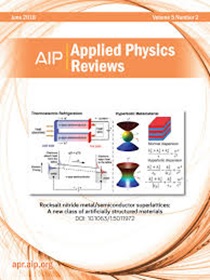Semiconductor waste-derived LiGaO2: A multifunctional regulator for crystallization, ion transport, and stability in polymer electrolytes
IF 11.6
1区 物理与天体物理
Q1 PHYSICS, APPLIED
引用次数: 0
Abstract
Succinonitrile (SN)-based composite polymer electrolytes offer high ionic conductivity and flexibility for solid-state lithium metal batteries (SSLMBs); however, they suffer from cyano group-induced interfacial side reactions and PVDF's crystallinity-driven performance limitations. Herein, we introduce semiconductor waste-derived LiGaO2 (LGO) as a multifunctional additive to address these challenges. LGO's high-dielectric constant modulates PVDF-HFP crystallization into disordered amorphous domains, reducing interfacial resistance and enhancing exchange current density. Simultaneously, LGO promotes LiTFSI dissociation via dipole interactions while anchoring SN molecules, suppressing migration and side reactions. The optimized electrolyte achieves an ionic conductivity of 1.24 × 10−3 S·cm−1, a transference number of 0.67, an activation energy of 0.13 eV, and a critical current density of 0.8 mA·cm−2 at 45 °C. Symmetric Li cells show stable cycling, while LiCoO2/Li batteries exhibit superior rate performance (111.8 mAh·g−1 at 2 C) and retain 61.4% capacity after 100 cycles at 0.5 C with 99.2% average Coulombic efficiency. These findings reveal the core mechanism of high-dielectric constant nanomaterials in regulating crystallization kinetics and promoting internal ionic transport in multicomponent polymer electrolytes, providing new directions for the development of SSLMBs.半导体废弃物衍生的LiGaO2:聚合物电解质中结晶、离子传输和稳定性的多功能调节剂
丁二腈(SN)基复合聚合物电解质为固态锂金属电池(sslmb)提供高离子导电性和灵活性;然而,它们受到氰基引起的界面副反应和PVDF的结晶度驱动的性能限制。在此,我们引入半导体废物衍生的LiGaO2 (LGO)作为多功能添加剂来解决这些挑战。LGO的高介电常数调制了PVDF-HFP结晶成无序的非晶畴,降低了界面电阻,提高了交换电流密度。同时,LGO通过偶极相互作用促进LiTFSI解离,同时锚定SN分子,抑制迁移和副反应。优化后的电解质在45℃时的离子电导率为1.24 × 10−3 S·cm−1,转移数为0.67,活化能为0.13 eV,临界电流密度为0.8 mA·cm−2。对称锂电池表现出稳定的循环性能,而LiCoO2/Li电池表现出优异的倍率性能(2℃时为111.8 mAh·g−1),在0.5℃下循环100次后容量保持61.4%,平均库仑效率为99.2%。这些发现揭示了高介电常数纳米材料在多组分聚合物电解质中调控结晶动力学和促进内部离子传输的核心机制,为sslmb的发展提供了新的方向。
本文章由计算机程序翻译,如有差异,请以英文原文为准。
求助全文
约1分钟内获得全文
求助全文
来源期刊

Applied physics reviews
PHYSICS, APPLIED-
CiteScore
22.50
自引率
2.00%
发文量
113
审稿时长
2 months
期刊介绍:
Applied Physics Reviews (APR) is a journal featuring articles on critical topics in experimental or theoretical research in applied physics and applications of physics to other scientific and engineering branches. The publication includes two main types of articles:
Original Research: These articles report on high-quality, novel research studies that are of significant interest to the applied physics community.
Reviews: Review articles in APR can either be authoritative and comprehensive assessments of established areas of applied physics or short, timely reviews of recent advances in established fields or emerging areas of applied physics.
 求助内容:
求助内容: 应助结果提醒方式:
应助结果提醒方式:


